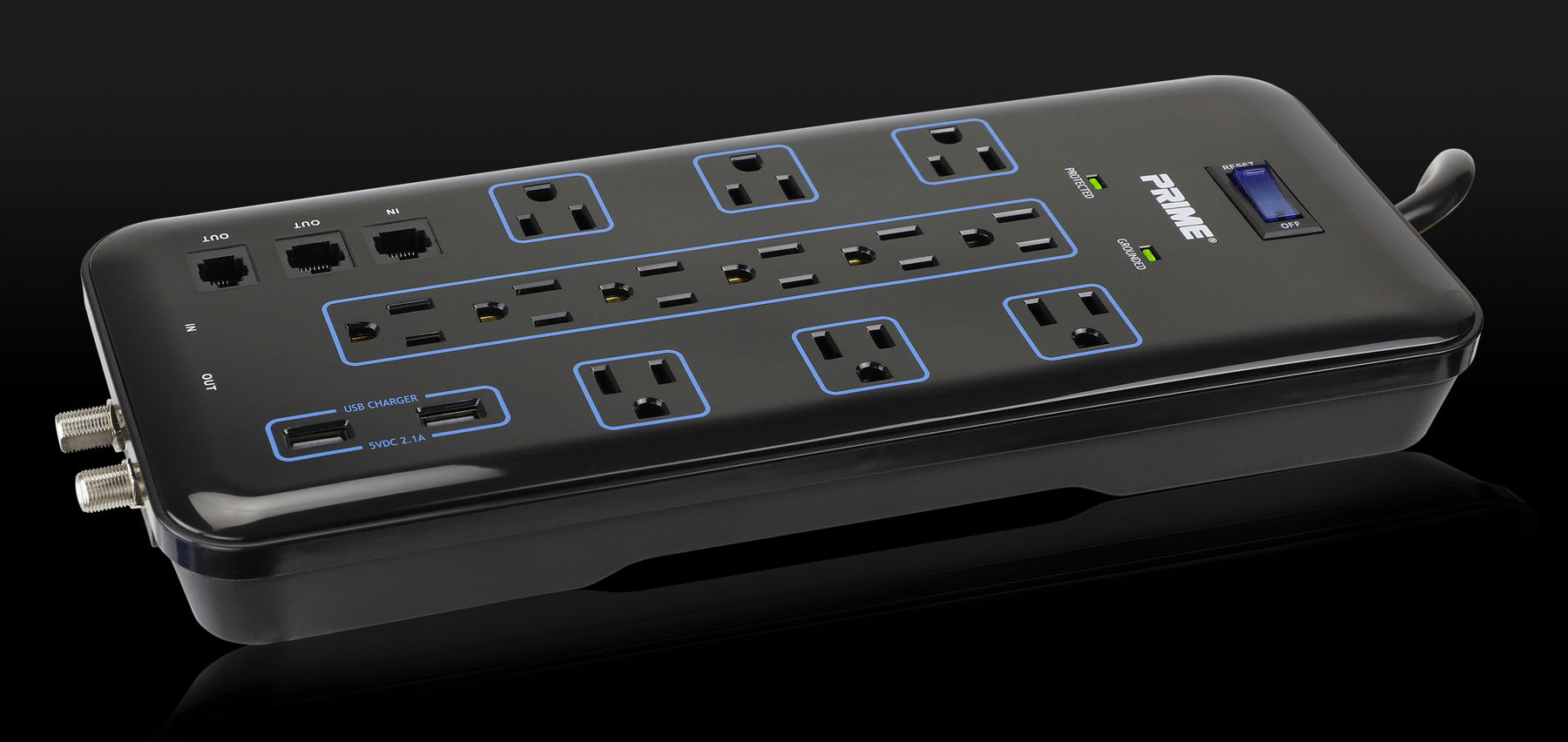
When to use a Power Strip vs. Surge strip
What is the difference between a power strip and surge protector? They look virtually identical, but one is much cheaper. Why can’t I just buy the cheaper looking one? Knowing what both are capable of can be an important advantage to protecting the electronics in your home. Both items are used for different purposes in different settings. There are several variables that will influence your decision on whether to use a power strip vs a surge protector. Let’s discuss the differences between the two items and describe a few settings in which both can be utilized in.
What is a Power Strip?
A power strip can be described as an extension cord attached to a strip that can have several outlets. The receptacles affixed to the strip serve as multiple outlets for power for other devices to be plugged into. The cable is plugged into the wall then anything you plug into the receptacles on the strip will be powered by that wall outlet. It basically serves as another extension cord but with more outlets to power multiple devices at once. Power strips are typically designed to just transfer power and be additional outlet, not to stop surges in power. You can typically find the electrical limits on a power strip from its packaging or behind the actual strip. Be aware of what items are being plugged into the power strip, putting too many devices or devices that take a lot of power can result in overheating, electrical failure, or worse. It is important to realize what devices are being plugged into the strip to avoid any hazards, some items, portable heaters for example, do not recommend using a power strip and should be plugged directly into a wall outlet. Power strips are usually easy to turn on and off, many have the single on/off switch that enables you to kill power to all the connected devices at once.
What is a Surge Protector Strip?
A surge protector can look very identical to a power strip but their functions differ slightly. A surge protector basically protects all your other connected devices from a power surge. A power surge occurs in your home when your supply of electricity is interrupted. A surge protector is basically an electrical socket that protects your devices from a sudden change in electrical voltage or spike in electricity. It uses a specialized circuit to redirect spikes of electricity into a small circuit board without passing the electricity to your devices. This helps regulate the amount of electricity that goes through your devices, when higher than normal electricity is detected it will cut off the supply to your devices. Redirecting this power means your devices will be protected from being zapped or fried. Surge protectors have an on/off switch as well but when a spike occurs the light on the switch will change. When this happens you usually need to flip the switch so the electricity can be flowed through the strip once again, but beware the surge protector aspect may have “served its purpose” protected your devices and need to be replace. A $30 surge protector is a much cheaper investment than having to replace a dead $1800 LCD TV. A surge protector will cost you a bit more than a power strip because of the specialized circuit used to protect your devices and many times they look like a really buff power strip. You can think of it like a power strip but on steroids. Price will differ depending on the amount of joules your surge protector can protect against. Make sure you have a surge protector that has a high enough joule rating to protect the items connected to it. To learn more about joules, please see our blog: 3 Simple Tips to Choose the Right Surge Protector.
Usage and location of power strips and surge protectors.
Office
Power strips can be commonly found in most office settings because they provide multiple receptacles for office equipment. Typically, devices plugged into these strips won’t require large amounts of power to operate. These devices can range from a mechanical stapler, shredder, office fan, etc. However, if you wanted to connect a large office printer, computer, monitor, or fax machine then it would be best to connect them to a surge protector. There are some devices you would want to protect in case of any power surges such as your computer tower, monitor screen, and desk telephone. You ideally want to protect devices that are expensive.
Home
Both power strips and surge protectors can be found within a home. Depending on where you place them and which devices are plugged in will determine which one would best to use. Some devices that should be plugged into surge protectors can be a high-end electronics, such a TV, computers or a refrigerator. Both these devices take large amounts of energy from your home and can influence surges. You would preferably want these items protected in your home from power surges. The simple rule is if you want to protect your device from random spikes in electricity, then use a surge protector.
Workshop station
Make sure you plug in your surge protector or power strip into an area where it is safe from exterior damage. Especially any tools or large equipment in your garage or work shed that can potentially fall and damage these. Preferably, you would want to use surge protectors in your workstation, to protect your expensive power tools from being fried by unwanted surges. In a setting where power is being abruptly absorbed and shut off, it would be ideal to use a surge protector when plugging in an assortment of power tools. If you plan to use a power strip in your garage, be sure you are plugging in devices that don’t need protection. A long industrial power strip can be very useful to charge all the batteries needed for your tools or for a radio, vacuum or table saw. Please see our website for a copy of our catalog or visit https://primewirecable.com/collections/surge-protectors-power-centers for more information on our power strips and surge protectors.
